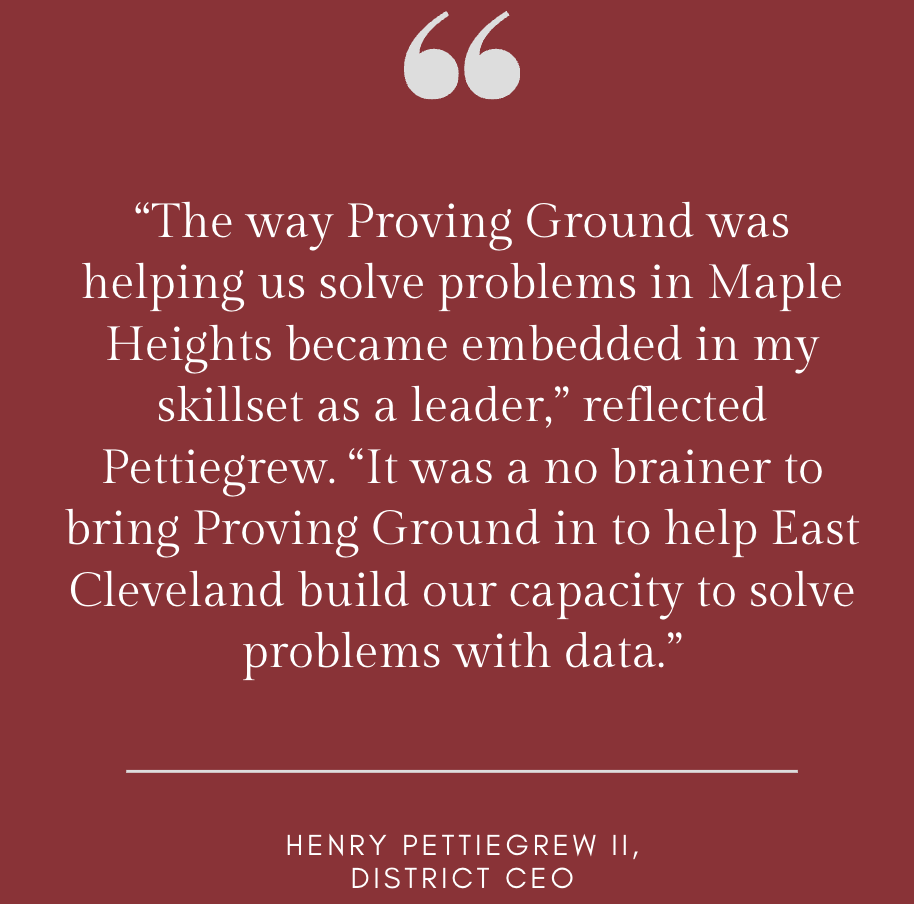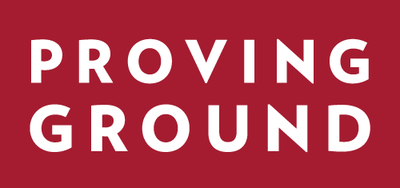November 20, 2020
For these districts, Proving Ground’s impact stretched beyond the initial partnership.
Every 20 days, groups of professionals from East Cleveland City Schools gather to assess and often modify the activities that influence their students’ performance. An approach born from the district’s partnership with Proving Ground, this three-week cycle allows stakeholders at all levels—from administrators to students—to check progress on high-priority benchmarks and make adjustments if necessary. The district knew that assessing how students are doing within this small window of time would allow them to stay agile and efficient with their strategies for student success. What they didn’t know is how important that agility would prove to be in 2020.
Rewind a few years, and East Cleveland City Schools were deeply struggling. “Back around 2015,” said Tom Domzalski, Director of Data Research and Assessment for the district, “about 50% of our students were scoring in the lowest scoring tier for student achievement, with another 25% scoring just one tier above that. So essentially, 75% of our students weren’t scoring at a proficient level on the state’s end-of-year tests.” The district went into an academic stress situation and brought Henry Pettiegrew II in as district CEO. Having worked with Proving Ground in the neighboring district of Maple Heights, Henry turned to Proving Ground for help.
 “The way Proving Ground was helping us solve problems in Maple Heights became embedded in my skillset as a leader,” reflected Pettiegrew. “It was a no brainer to bring Proving Ground in to help East Cleveland build our capacity to solve problems with data.”
“The way Proving Ground was helping us solve problems in Maple Heights became embedded in my skillset as a leader,” reflected Pettiegrew. “It was a no brainer to bring Proving Ground in to help East Cleveland build our capacity to solve problems with data.”
While Proving Ground was initially brought in to help tackle one particular issue facing the district, chronic absenteeism, the team’s approach to thinking critically about attendance permeated the district’s culture. “Proving Ground equipped us with the tools to tackle chronic absenteeism, and we were able to then fold that process into our instructional model to help with student achievement,” Henry added.
Neighboring Maple Heights City School District, who also worked on chronic absenteeism with Proving Ground, found the group’s approach similarly far-reaching. “Our work with Proving Ground had gone beyond our work on chronic absenteeism and has trickled into academics and strategic planning,” said Shay Price, Maple Heights High School Principal. “For example, part of Proving Ground’s action plan builds in opportunities for stakeholder engagement. Thus, heading into the third year of our strategic plan, we met with stakeholder groups and employed many of the skills—root cause analysis, intervention mapping, and accountability—we got from Proving Ground.”
Proving Ground has long strived to help make continuous improvement business-as-usual for districts. Deep dives into their historical data and a logical framework for identifying, testing, and scaling high-impact and low-investment solutions have set partners up to quickly respond to change. The process is iterative and intuitive, incorporating evidence into the daily work of more than 60 education agencies that support almost 400,000 students nationwide.
Both districts, East Cleveland and Maple Heights, had already begun to expand their applications of Proving Ground’s framework to issues like academics and tardiness when the coronavirus pandemic shuttered schools nationwide.
“Immediately when COVID-19 hit, we started talking about the digital divide and other issues affecting our students during coronavirus,” noted Henry. Many households in Cleveland are unconnected in terms of internet access and access to computers—a major issue in the face of coronavirus shutdowns. “We used the Proving Ground process to identify and troubleshoot the issues facing our community and potential interventions we could implement.”
The district’s rapid review cycle, too, proved vital to the district’s response to the pandemic’s dynamic pressures.
“COVID actually affirmed the stability of our system,” added Tom. “We can take our 20-day cycle, whether we’re in a face-to-face, blended, or completely online format, and continue to gauge the needs and learning of our people. It allowed us a structure to fix any broken systems, shore up existing systems, or create completely new systems when needed. The pandemic is new, and it requires new solutions. Had we not had this framework for thinking about complex problems, we would have been much further behind in helping our kids learn during COVID.”
COVID-19 is having a far-reaching and multifaceted impact on schools as they direct more resources and attention toward COVID-related issues. And longer-term issues around absenteeism and student achievement will undoubtedly persist, if not worsen, through the pandemic. Rather than slowing or stopping work on these longer-term goals, leaders equipped with the skills and tools of Proving Ground can maintain focus on what matters most during an unprecedented school year.
And indeed, the thought of helping provide a way forward for those showing up for the nation’s students is a powerful driver for the Proving Ground team. “During the COVID-19 pandemic, we are committed to helping people move forward,” said David Hersh, Proving Ground’s director. “We started working with our partners around attendance but the process itself is designed to help find solutions for any problems our partners face. The pandemic shows just how critical it is for educators to be able to quickly and thoughtfully address challenges. We’re grateful to have partners engaged enough to let us help.”
